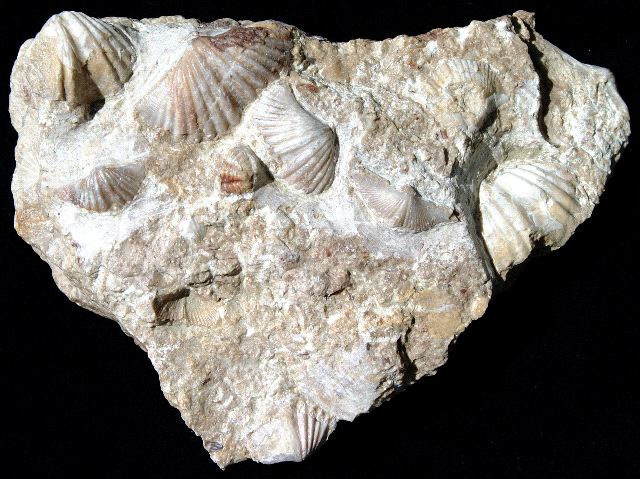Life in the sea
The seas and oceans of the Devonian Period provided highly favourable habitats for life.
 (76 kb) Sea levels rose considerably toward the middle of this period, and the edges of the continents were covered by warm, shallow seas – a situation that promoted the development of reef communities in equatorial regions. The main components of these great barrier reefs were rugose and tabulate corals, and stromatoporoids – a long-vanished sponge with a calcified skeleton. The extinction event at the end of the Devonian wiped out the classic coral-stromatoporoid association that had dominated the great reefs of Silurian and Devonian times.
(76 kb) Sea levels rose considerably toward the middle of this period, and the edges of the continents were covered by warm, shallow seas – a situation that promoted the development of reef communities in equatorial regions. The main components of these great barrier reefs were rugose and tabulate corals, and stromatoporoids – a long-vanished sponge with a calcified skeleton. The extinction event at the end of the Devonian wiped out the classic coral-stromatoporoid association that had dominated the great reefs of Silurian and Devonian times.
The seafloor was still dominated by brachiopods during Devonian time, but only a few descendants survive in modern seas. Bivalve molluscs evolved into diverse and abundant shellfish in the shallow coastal waters, where they still thrive today. The great nautiloid molluscs began to decline, but gave rise to the ammonoids, who became omnipresent in Mesozoic seas. Echinoderms, mostly crinoids (“sea lilies”), created veritable underwater “fields”. And trilobites, although common, had suffered a series of extinctions and were less diversified than they once had been. Sadly, they would be practically decimated at the end of the Devonian.
Although already present during the Devonian, sharks were not yet the kings of the sea. Instead, the role of top predator belonged to the placoderms, particularly the arthrodire group. One arthrodire species found in Ohio, Dunkleosteus, could grow up to 9 metres long! Mingling with these giants were representatives of the classes of scaly fish: the actinopterygians, acanthodians and sarcopterygians.
Things changed dramatically, however, at the end of the Devonian Period when the retreat of the great epicontinental seas provoked a serious decline in the number of creatures living the world’s oceans.

 (76 kb) Sea levels rose considerably toward the middle of this period, and the edges of the continents were covered by warm, shallow seas – a situation that promoted the development of reef communities in equatorial regions. The main components of these great barrier reefs were rugose and tabulate corals, and stromatoporoids – a long-vanished sponge with a calcified skeleton. The extinction event at the end of the Devonian wiped out the classic coral-stromatoporoid association that had dominated the great reefs of Silurian and Devonian times.
(76 kb) Sea levels rose considerably toward the middle of this period, and the edges of the continents were covered by warm, shallow seas – a situation that promoted the development of reef communities in equatorial regions. The main components of these great barrier reefs were rugose and tabulate corals, and stromatoporoids – a long-vanished sponge with a calcified skeleton. The extinction event at the end of the Devonian wiped out the classic coral-stromatoporoid association that had dominated the great reefs of Silurian and Devonian times.The seafloor was still dominated by brachiopods during Devonian time, but only a few descendants survive in modern seas. Bivalve molluscs evolved into diverse and abundant shellfish in the shallow coastal waters, where they still thrive today. The great nautiloid molluscs began to decline, but gave rise to the ammonoids, who became omnipresent in Mesozoic seas. Echinoderms, mostly crinoids (“sea lilies”), created veritable underwater “fields”. And trilobites, although common, had suffered a series of extinctions and were less diversified than they once had been. Sadly, they would be practically decimated at the end of the Devonian.
Although already present during the Devonian, sharks were not yet the kings of the sea. Instead, the role of top predator belonged to the placoderms, particularly the arthrodire group. One arthrodire species found in Ohio, Dunkleosteus, could grow up to 9 metres long! Mingling with these giants were representatives of the classes of scaly fish: the actinopterygians, acanthodians and sarcopterygians.
Things changed dramatically, however, at the end of the Devonian Period when the retreat of the great epicontinental seas provoked a serious decline in the number of creatures living the world’s oceans.
Site map | Feedback | Links | Sources | Credits
Life in the sea
<< The animal world | The diversification of fish >>



